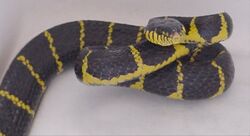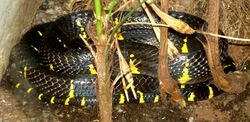Biology:Boiga
| Boiga | |
|---|---|

| |
| Boiga dendrophila, mangrove snake | |
| Scientific classification | |
| Domain: | Eukaryota |
| Kingdom: | Animalia |
| Phylum: | Chordata |
| Class: | Reptilia |
| Order: | Squamata |
| Suborder: | Serpentes |
| Family: | Colubridae |
| Subfamily: | Colubrinae |
| Genus: | Boiga Fitzinger, 1826 |
Boiga is a large genus of rear-fanged, mildly venomous snakes, known commonly as cat-eyed snakes or simply cat snakes, in the family Colubridae. Species of the genus Boiga are native to southeast Asia, India , and Australia , but due to their extremely hardy nature and adaptability, have spread to many other suitable habitats around the world. There are 38 recognized species in the genus. According to the study done by Jiří Smíd regarding Old World cat snakes, the ancestor of the cat snake originated in Africa, from where it diversified and expanded to other countries. Despite this diversity however, the different species have very similar needs in terms of temperature and precipitation.[1]
Species and subspecies

The following species and subspecies are recognized as being valid.[2]
- Boiga andamanensis (Wall, 1909) – Andaman cat snake
- Boiga angulata (W. Peters, 1861) – Leyte cat snake
- Boiga barnesii (Günther, 1869) – Barnes' cat snake
- Boiga beddomei (Wall, 1909) – Beddome's cat snake
- Boiga bengkuluensis Orlov, Kudryavtzev, Ryabov & Shumakov, 2003
- Boiga bourreti Tillack, Ziegler & Le Khac Quyet, 2004
- Boiga ceylonensis (Günther, 1858) – Sri Lanka cat snake
- Boiga cyanea (A.M.C. Duméril, Bibron & A.H.A. Duméril, 1854) – green cat snake
- Boiga cynodon (F. Boie, 1827) – dog-toothed cat snake
- Boiga dendrophila (F. Boie, 1827) – gold-ringed cat snake, mangrove snake
- Boiga dendrophila annectens (Boulenger, 1896)
- Boiga dendrophila dendrophila (F. Boie, 1827)
- Boiga dendrophila divergens Taylor, 1922
- Boiga dendrophila gemmicincta (A.M.C. Duméril, Bibron & A.H.A. Duméril, 1854)
- Boiga dendrophila latifasciata (Boulenger, 1896)
- Boiga dendrophila levitoni Gaulke, Demegillo & G. Vogel, 2005
- Boiga dendrophila multicincta (Boulenger, 1896)
- Boiga dendrophila occidentalis Brongersma, 1934
- Boiga dightoni (Boulenger, 1894) – Pirmad cat snake
- Boiga dightoni whitakeri Ganesh, Mallik, Achyuthan, Shanker & G. Vogel, 2021 – Whitaker's cat snake
- Boiga drapiezii (H. Boie in F. Boie, 1827) – white-spotted cat snake
- Boiga flaviviridis G. Vogel & Ganesh, 2013
- Boiga forsteni (A.M.C. Duméril, Bibron & A.H.A. Duméril, 1854) – Forsten's cat snake
- Boiga gocool (Gray, 1835) – arrowback tree snake
- Boiga guangxiensis Wen, 1998
- Boiga hoeseli Ramadhan, Iskandar & Subasri, 2010
- Boiga irregularis (Merrem, 1802) – brown tree snake
- Boiga jaspidea (A.M.C. Duméril, Bibron & A.H.A. Duméril, 1854) – jasper cat snake
- Boiga kraepelini (Stejneger, 1902) – Kelung cat snake
- Boiga melanota (Boulenger, 1896)
- Boiga multifasciata (Blyth, 1861) – many-banded cat snake
- Boiga multomaculata (F. Boie, 1827) – many-spotted cat snake
- Boiga nigriceps (Günther, 1863) – black-headed cat snake
- Boiga nuchalis (Günther, 1875) – collared cat snake
- Boiga ochracea (Günther, 1868) – tawny cat snake
- Boiga philippina (W. Peters, 1867) – Philippine cat snake
- Boiga quincunciata (Wall, 1908)
- Boiga ranawanei (Samarawickrama, Samarawickrama, Wijesena, & Orlov, 2005) – Ranawana's cat snake
- Boiga saengsomi Nutphand, 1985 – banded cat snake
- Boiga schultzei Taylor, 1923 – Schultze's blunt-headed tree snake
- Boiga siamensis (Nutphand, 1971) – gray cat snake
- Boiga tanahjampeana Orlov & Ryabov, 2002
- Boiga thackerayi Giri, Deepak, Captain, Pawar & Tillack, 2019 – Thackeray's cat snake
- Boiga trigonata (Schneider, 1802) – Indian gamma snake
- Boiga trigonata trigonata (Schneider, 1802)
- Boiga trigonata melanocephala (Annandale, 1904)
- Boiga wallachi Das, 1998 – Nicobar cat snake
- Boiga westermanni Reinhardt, 1863 – Indian egg-eating snake
Nota bene: A binomial authority in parentheses indicates that the species was original described in a genus other than Boiga.
Description
Cat snakes are long-bodied snakes with large heads and large eyes. They vary greatly in pattern and color. Many species have banding, but some are spotted and some are solid-colored. Colors are normally black, brown, or green with white or yellow accents.[citation needed]
Behaviour
Snakes of the genus Boiga are primarily arboreal,[3] nocturnal snakes.[citation needed]
Diet
Snakes of the genus Boiga prey on various small species of lizards, snakes, birds, and mammals.[citation needed]
Venom
The toxicity of Boiga venom varies from species to species, but is not generally considered to be life-threatening to humans. Since their venom does not usually harm humans, they are popular exotic pets.[citation needed]
Reproduction
Boiga species are oviparous.[4]
In captivity
Boiga dendrophila is by far the most common species in captivity, but B. cyanea and B. nigriceps are also found. Nowadays, B. cynodon, B. philippina and a “Katherine morph” of B. irregularis are also circulating in the South-East Asian exotic pet trade. Others are not commonly available. They are hardy and adaptable and tend to do well in captivity after the initial period of stress from the importation process is passed. They are not bred commonly in captivity, so most specimens available are wild caught, and thus are prone to heavy internal parasite load. Adjusting them to a rodent only diet can be difficult for the inexperienced reptile keeper.[citation needed]
Invasive species
Boiga irregularis in particular has been federally banned in the United States because of its effect by accidentally being introduced to the island of Guam. Some time during the 1950s, some B. irregularis of both sexes (or possibly a single female with eggs) reached the island, possibly having hidden in imported plant pots. The island of Guam lacks native snakes or predators that can deal with snakes the size and aggressiveness of B. irregularis. As a result, it has bred unchecked as an invasive species, and has begun consuming the island's bird life in extreme numbers. Dozens of bird species have been completely eradicated from the island, many species that were found nowhere else on earth, and the snake has reached astonishing population densities, reported to be as high as 15,000 snakes per square mile. In addition to devouring the native fauna, this species will routinely crawl into power transformers, and this typically results in both an electrocuted snake and substantial blackouts.[5] In addition, there has been many cases in Guam where deaths are recorded due to the venomous bites from the Boiga snakes. Although they are an invasive species, there has been evidence where there is reverse- colonization of South-East Asia from the Philippines, and the Australasia from Wallacea from multiple lineages within Boiga.
References
- ↑ Genus Boiga at Wikispecies. species.wikimedia.org/wiki/Boiga.
- ↑ Genus Boiga at The Reptile Database www.reptile-database.org.
- ↑ Goin CJ, Goin OB, Zug GR (1978). Introduction to Herpetology, Third Edition. San Francisco: W.H. Freeman and Company. xi + 378 pp. ISBN:0-7167-0020-4. (Genus Boiga, p. 324).
- ↑ Rodda GH, Fritts TH, McCoid MJ, Campbell EW III (1999). "An Overview of the Biology of the Brown Treesnake (Boiga irregularis), a Costly Introduced Pest on Pacific Islands". pp. 44-80. In: Rodda GH, Sawai Y, Chiszar D, Tanaka H (editors) (1999). Problem Snake Management: the Habu and the Brown Treesnake. Ithaca, New York: Comstock Publishing Associates, a Division of Cornell University Press. 534 pp. ISBN:978-0801435072. http://www.stoppinginvasives.org/dotAsset/aa46f8a3-9334-4e55-b724-5f63ffaffc7f.pdf
- ↑ "The Brown Treesnake on Guam". Fort Collins Science Center, United States Geological Survey. http://www.fort.usgs.gov/resources/education/bts/.
Further reading
- Fitzinger LI (1826). Neue Classification der Reptilien nach ihren natürlichen Verwandtschaften. Nebst einer Verwandtschafts-tafel und einem Verzeichnisse der Reptilien-Sammlung des k.k. zoologischen Museums zu Wien. Vienna: J.G. Heubner. five unnumbered + 67 pp. + one plate. (Boiga, new genus, p. 60). (in German and Latin).
External links
- Wild Herps.com: Eastern Brown Tree Snake
- Gernot-Vogel.de: Checklist of the Genus Boiga (Serpentes: Colubridae)
Wikidata ☰ Q1475483 entry
 |

